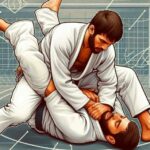Introduction:
Table of Contents
Choosing a combat sport can be an exciting yet daunting task. With various options available, each boasting its unique techniques and benefits, it’s essential to understand which one aligns best with your interests and goals. In this comprehensive guide, we’ll delve into the world of combat sports, comparing popular options like Boxing, MMA (Mixed Martial Arts), and Jiu-Jitsu. By the end, you’ll have a clearer picture of which combat sport suits you best.

Comparing 3 Combat Sports to Find the Best
Discover the differences between popular combat sports such as Boxing, MMA, and Jiu-Jitsu, and find out which one suits you best.
I. Boxing: The Sweet Science
Boxing, often referred to as “The Sweet Science,” is a centuries-old sport that focuses on striking with the fists. Here’s what you need to know:
Techniques:
- Primarily involves punching techniques such as jabs, crosses, hooks, and uppercuts.
- Footwork plays a crucial role in maneuvering around opponents and maintaining balance.
- Defense techniques include blocking, parrying, and evasive maneuvers like slipping and weaving.
Benefits:
- Improves cardiovascular health and stamina.
- Enhances hand-eye coordination and reflexes.
- Builds discipline, focus, and mental toughness.
History and Evolution:
- Boxing traces its origins back to ancient civilizations such as Greece and Rome, where it was often practiced as a form of entertainment and combat training.
- Modern boxing rules were established in the late 19th and early 20th centuries, with the introduction of weight classes, rounds, and regulations to ensure safety.
- Over the years, boxing has evolved into a highly technical and strategic sport, with legendary fighters like Muhammad Ali, Mike Tyson, and Floyd Mayweather Jr. captivating audiences worldwide.
II. MMA (Mixed Martial Arts): The Ultimate Test of Versatility
MMA has surged in popularity, showcasing a blend of various martial arts disciplines. Here’s a breakdown:
Techniques:
- Combines striking techniques from disciplines like Boxing, Muay Thai, and Kickboxing with grappling techniques from Jiu-Jitsu, Judo, and Wrestling.
- Involves striking with fists, elbows, knees, and legs, as well as clinching and ground fighting.
- Requires proficiency in both striking and grappling to excel.
Benefits:
- Provides a comprehensive full-body workout.
- Enhances versatility and adaptability in combat situations.
- Fosters mental resilience and problem-solving skills.
History and Evolution:
- MMA’s roots can be traced back to ancient civilizations, where various forms of mixed combat were practiced for self-defense and sport.
- Modern MMA as we know it today emerged in the late 20th century, with the founding of organizations such as the Ultimate Fighting Championship (UFC) in 1993.
- The sport has since evolved rapidly, with athletes from diverse backgrounds honing their skills to compete at the highest levels of competition.
III. Jiu-Jitsu: The Art of Ground Fighting
Jiu-Jitsu focuses on ground fighting and submission techniques, making it highly effective for self-defense. Let’s explore:
Techniques:
- Emphasizes leverage and technique over brute strength.
- Includes various joint locks, chokes, and submission holds designed to control opponents.
- Ground fighting skills such as sweeps, transitions, and escapes are essential.
Benefits:
- Enhances self-defense skills, particularly in close-quarters and ground-based scenarios.
- Promotes flexibility, balance, and body awareness.
- Fosters patience, humility, and respect through disciplined training.
History and Evolution:
- Jiu-Jitsu originated in Japan centuries ago, with different schools and styles emerging over time, including traditional Japanese Jiu-Jitsu and Brazilian Jiu-Jitsu (BJJ).
- Brazilian Jiu-Jitsu gained prominence in the 20th century thanks to the Gracie family, who popularized the art through their success in early MMA competitions.
- Today, Jiu-Jitsu is practiced worldwide, with numerous competitions and academies dedicated to honing its techniques.
Table of Information:
| Combat Sport | Techniques | Benefits |
|---|---|---|
| Boxing | Punching, footwork, defense techniques | Cardiovascular health, hand-eye coordination, mental toughness |
| MMA | Striking, grappling, clinching | Full-body workout, versatility, mental resilience |
| Jiu-Jitsu | Ground fighting, submission holds | Self-defense skills, flexibility, humility |
Conclusion:
In the realm of combat sports, there’s no one-size-fits-all answer to the question of which is best. Boxing offers a classic and straightforward approach to striking, ideal for those who enjoy the purity of the sport. MMA appeals to individuals seeking versatility and a comprehensive skill set, combining various martial arts disciplines into one dynamic package. On the other hand, Jiu-Jitsu provides a unique focus on ground fighting and submission holds, suited for those who prefer close-quarters combat and self-defense scenarios. Ultimately, the best combat sport for you depends on your interests, goals, and personal preferences.
Frequently Asked Questions (FAQs):
- Q: Which combat sport is the most physically demanding?
- A: MMA is often considered the most physically demanding due to its diverse skill set and rigorous training regimen.
- Q: Can anyone participate in combat sports, regardless of age or gender?
- A: Yes, most combat sports welcome participants of all ages and genders, with appropriate training and supervision.
- Q: Are combat sports dangerous?
- A: Like any physical activity, combat sports carry inherent risks. However, with proper training, supervision, and adherence to safety guidelines, the risks can be minimized.
- Q: How long does it take to become proficient in a combat sport?
- A: The time it takes to become proficient varies depending on factors such as natural ability, dedication to training, and the complexity of the sport. Generally, consistent training over several years is required to achieve mastery.
- Q: Can combat sports help with self-defense?
- A: Yes, combat sports like Jiu-Jitsu are specifically designed to enhance self-defense skills, teaching participants how to neutralize threats and protect themselves in real-world situations.


